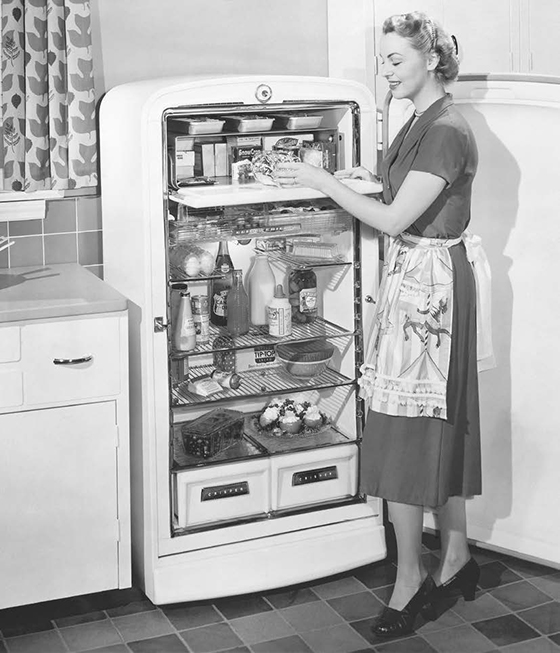Interview with Paola Guidi
Historically, appliances such as the washing machine and the refrigerator, when they first appeared, helped the emancipation of women by freeing them from the slavery of daily washing and shopping. This represented a huge change in our societies’ lifestyles in the mid 20th Century. Then, the influence of Design over this industry gained progressive importance, even more so in the past 20 years. According to journalist Paola Guidi, one of the most internationally respected specialist of the home appliances industry, products are no longer conceived solely in terms of functionality, but also and most importantly as design objects. Nowadays, responsible choices when it comes to sustainable materials and technologies are also fundamental. In all this, OEMs have had the capacity to catch emerging trends in the global markets and perfectly interpret their client’s final customer’s needs and aspirations, translating them into successful products.
How did things turn out this way?
The industry wouldn’t be what it is today if refrigerators and other appliances hadn’t been introduced on a massive scale in Europe in the aftermath of WWII. Though they already were quite popular in the US, American design and technologies at the time were rather basic and quite expensive. Europe’s economic boom of the late 50’s and 60’s sparked the demand for ever more sophisticated and trendy models, and Europeans, especially the Italians, where considered the world excellence of design. At the time, Italy’s capacity to deliver products that were affordable even by the lower classes of society and that combined superior design with modern technology, stood at the base of the unprecedented growth of the appliance market in the post war era. In parallel with Europe’s expansion of its domestic industry and growing sophistication, the evolution of China’s social landscape, with the emergence of a new middle class, with its own set of aspirations and needs to cater for, lead to the development of huge manufacturing capacity in the region. When I went to China for the first time, a few years ago, a Chinese journalist friend invited me to his house. I was shocked to find a beautiful refrigerator, with mirror-finish doors, in the living room. It was an object to show-off to visitors. The same used to happen in Italy only a few years back, especially in the South: dishwashers were typically on display for visitors to admire, with lace doilies on top and all.
Milan-based Paola Guidi is considered Europe’s doyenne of home tech journalism and the utmost specialist in home appliances and domotics as well as domestic safety. In her long career she started as a crime news reporter before taking on positions of increasing responsibility she has worked for some of Italy’s most important dailies and magazines such as Repubblica, Il Messaggero and Sole24Ore, with which she still collaborates today. For several years she also had a regular column in Germany’s Der Spiegel, and she is known and respected worldwide in the global community of appliance makers, distributors and retailers as a cultural reference in the industry.
What was so special about European design at the time?
Instead of manufacturing heavy, expensive and energy-inefficient appliances for the well-off, Europeans applied the principles of industrial design to the mass production of refrigerators and washing-machines. It is not by accident that the first Compasso d’Oro awards in this industry went to an Ignis refrigerator and a Candy washing machine. They were modular and had a linear, minimal look. Built-in was also introduced. All this at unbeatable prices. Italy was truly the first OEM producer of the world, soon succeeded by China and, more recently, Turkey. Italy was so powerful at the time that, as I recounted on several occasions, Lino Zanussi was believed to being on the verge of buying the all-mighty Electrolux, before his tragic death in the crash of his private plane.What happened in the past 20 years?
All of the great industrial revolutions do come with some kind of involution. At the turn of the Millennium, production had become globalised, with the supply chain stretching across the planet. There was a situation of overproduction in the US, Europe and Asia. This caused retail prices to collapse, especially since the large retail chains had started a price-war. Special promotions and massive discounts became commonplace, but most of all, products were totally mass-market and hardly distinguishable from one another: the so-called “sea-of-white”. Appliances became a mere commodity, with very little innovation to them. For what concerned refrigerators the only criteria involved were capacity, temperature and above all, price.However, society’s consumption and eating habits were changing, with new trends emerging. Consumers aspired to a healthier lifestyle, and felt the need to better preserve their food, especially fresh produce and ingredients. Products at the time were certainly not meeting the markets’ demands. They were inefficient, they broke down often and service was generally not up to standards.
All industrial revolutions come with a natural involution
How and when did the industry react to these trends?
By that time the industry had become truly global, with trade barriers being less and less stringent. Consumer trends were also global, and the first tangible sign of the emerging trends was a radical change in people’s shopping habits. The demand for larger appliances started to grow. American style side-by-side refrigerators became all the hype, with the major brands turning to South-East-Asia’s OEMs to satisfy a steeply growing demand. In fact, this situation was both pulled by consumer demand and pushed by the industry since Asian OEMs were able to provide vast quantities of competitively priced extra large appliances, especially refrigerators and washing machines, contributing to this bigger-is-better trend, despite the fact that families tended to become smaller. World markets were taken by storm by this new generation of appliances that were proposing a new way of keeping food and doing your laundry, in other words a new lifestyle model. I think that to date the important role played by OEMs in what can be considered as a true revolution in the industry hasn’t yet been thoroughly analysed.Bigger is better
Was it only the size?
In parallel with the extra-large trend, there was a lot of attention devoted to aesthetics, too. It took after the success of Italy’s interior design and furniture, which strongly influenced the built-in sector. They say “beauty will save the world”, in this case it started early. Some Asian OEMs even started celebrating Italy’s Renaissance genius, art and culture in their own domestic markets. More importantly, the new appliances, according to the old Bauhaus mantra “Form und Funktion”, another eminently European concept, combined elegance and performance into one, beautiful to look at and superiorly efficient product.

How did technology change?
Today it’s no longer only a matter of technology. Performance must go together with beauty, and emotions, and a lot of other intangible features if one wants to appeal to the world markets, there’s no coming back. Trends are moving faster and faster, too. Side by sides are no longer the thing, we’re already onto French doors, and soon the refrigerator will become something different, with spaces that can transform and adapt to users’ needs. Some observers find it hard to follow, and you keep reading things like “it’s cooler at the bottom, and warmer at the top, so stock your fridge accordingly” in magazines, but the truth is that nowadays refrigerator technology is far more sophisticated than that, with compartments and whole areas of the appliance able to replicate the ideal “climate” for the best preservation of particular food items. It can be adapted, moved around, changed, fine-tuned to the exact specifications of individual consumers. One-fits-all is no longer acceptable. We’re not talking about temperature and humidity alone, but some appliances feature UV rays, odour removers, and even cameras among other things.What about the environment?
Energy efficiency and environment protection are high on the agenda. Over the decades, the refrigerator, being always turned on, is possibly the single appliance which misuse might have had the highest impact on the environment, also in terms of food waste. If I can watch what’s inside my fridge on my cellphone, I might not buy unnecessary items when I’m out shopping and avoid wasting what’s still available at home. Time is becoming the real super-premium commodity, and any time-saving solution is worthy of consideration. It started with security and CCTV cameras, which helped responding to intrusions and theft attempts in real time by letting you receive alerts on your watch or cellphone. Now the same might go with food items in your fridge approaching their expiry date, saving you the time to physically conduct a full survey of your fridge content.Beauty will save the world, and it started early
Does IoT have a role to play?
People buy connected appliances far more than expected. More than complete home-automation systems, consumers are preferring IoT connected products, building their own personal systems, especially young couples and millennials. Smart refrigerators and washers are ranking very high in appliance sales. There’s a lot of curiosity, especially in the UK and the US, where home security also ranks very high in families’ priorities. There’s a downturn to all this connectivity, though: hacking. Recently, some hackers launched an attack on connected fridges in affluent neighbourhoods in the US and caused the deliberate meltdown of all the ice cubes in the appliances! Although it was more of a prank than anything else, the mere fact that this could happen is cause for concern.

To conclude, what does the content of our fridges tell us about ourselves?
We’ve all seen those pictures of the typical fridge loads in different countries around the world. Beyond their entertainment value and discounting the cultural differences, they’re a sure telltale sign of a society’s degree of development. A fridge packed full of highly nourishing, protein-loaded foods generally tells the story of a hard-working family needing solid nourishment, and an emerging, expanding economy. The more affluent and sophisticated the society, the more organic, healthy and expensive items, often vacuum packed, will appear on the shelves, and also the emptier the fridge. This “fridgeanomics” indicator is allegedly used by a growing number of international corporate investors as part of their evaluation of the socio-economic environment of the prospective investments they are considering.Fridgeanomics measure a society’s development
Let’s talk about the energy label
It’s much simpler now, and criteria are more stringent too, especially for the “A” category. This clarity is certainly a good thing, especially with the price of electricity being so volatile. Consumers do pay attention to the energy label, a lot more than they did in the past. Since the energy label was introduced, giving consumers the possibility to identify and chose the more efficient products, it is estimated that we saved the planet the pollution equivalent of at least three mega-power plants.What’s the way forward as far as the refrigerator is concerned?
We’ll see many different types of “cool”, since the variety of food types will continue to grow and they’ll need to be adequately preserved. Organic and short supply chain foods are a strong trend, and we’ll probably buy more healthy, locally farmed produce in the years to come. So we might see a multiplication of smaller storage spaces with specific settings within the same fridge. Design will still be a crucial, distinctive feature. We might also see the appearance of separate, smaller units located in different areas of the kitchen, or even the house, such as drawers, cabinets, which are no novelty but this time they might all be connected, forming a multiclimate system managed from our smartphones for the most efficient use of our domestic spaces. Finally, one must consider the role of climate change in shaping the future of this particular appliance: traditional compressors might not be sufficient any longer to guarantee proper functioning in extreme heat, and might see a wider use of its more powerful, tropicalised version.Copyright © Homa 2024
All rights reserved

.jpg?VGhlIFBlcmZlY3QgU2xvdC1pbijmraPnoa4pLmpwZw==)












.jpg?MTkyMHg3MjDvvIhkZXPvvIkuanBn)
.jpg?MTAyNHg3NDDvvIhkZXPvvIkuanBn)



















